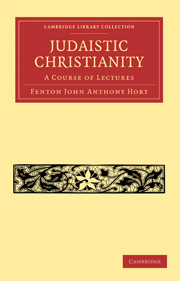Book contents
- Frontmatter
- PREFACE
- Contents
- I INTRODUCTORY LECTURE
- II CHRIST AND THE LAW
- III THE EARLY CHURCH AT JERUSALEM
- IV THE CHURCH OF ANTIOCH
- V THE INDEPENDENT ACTIVITY OF ST PAUL
- VI ST PAUL AT JERUSALEM AND THE EPISTLES OF THE ROMAN CAPTIVITY
- VII THE PASTORAL EPISTLES
- VIII JAMES, I PETER, HEBREWS, APOCALYPSE
- IX THE CHURCH OF JERUSALEM FROM TITUS TO HADRIAN
- X THE JUDAIZERS OF THE IGNATIAN EPISTLES
- XI CERINTHUS, ‘BARNABAS,’ JUSTIN MARTYR
- XII PALESTINIAN EBIONITES
- APPENDIX
- INDEX
- Frontmatter
- PREFACE
- Contents
- I INTRODUCTORY LECTURE
- II CHRIST AND THE LAW
- III THE EARLY CHURCH AT JERUSALEM
- IV THE CHURCH OF ANTIOCH
- V THE INDEPENDENT ACTIVITY OF ST PAUL
- VI ST PAUL AT JERUSALEM AND THE EPISTLES OF THE ROMAN CAPTIVITY
- VII THE PASTORAL EPISTLES
- VIII JAMES, I PETER, HEBREWS, APOCALYPSE
- IX THE CHURCH OF JERUSALEM FROM TITUS TO HADRIAN
- X THE JUDAIZERS OF THE IGNATIAN EPISTLES
- XI CERINTHUS, ‘BARNABAS,’ JUSTIN MARTYR
- XII PALESTINIAN EBIONITES
- APPENDIX
- INDEX
Summary
Ewald. Die drei ersten Evangelien (2nd Ed.), Vol. 1. pp. 263 f.
After commenting on S. Matt. v. 1—16, and noticing how suitably the striking figures of salt and light are there introduced he proceeds:
“This introductory passage fully describes the lofty and unique destiny to which the Twelve are called, and to which they must before all things remain true. It contains also an implicit reference to a Truth, which through the human instruments which propagate it, is to become the salt and light of the earth. It is time therefore to expound this fundamental principle of the New Covenant.
“This fundamental principle, seeing that the attitude in which the New Covenant is to stand to the Old is the all-important question, must be determined essentially by the relation of the New to the Old.
“It might easily be supposed that Christ came to destroy, i.e. to represent as invalid or of no obligation one of the two parts of the Old Covenant, either the Law or the Prophets, to cancel either the duties prescribed by the Law, or the promises and warnings uttered by the Prophets.
“But the reverse of this is true. He came to fulfil the whole of the Old Covenant (v. 17), to bring about the fulfilment required by its innermost meaning and purpose, with a view to which the germ had been originally implanted in it. So that the New is simply the fulfilment of the Old, and it is in this fulfilment, without any suppression or denial of the Old in the New as though it were something in itself perverted and intolerable, that the New finds its true commencement.[…]”
- Type
- Chapter
- Information
- Judaistic ChristianityA Course of Lectures, pp. 203 - 214Publisher: Cambridge University PressPrint publication year: 2009First published in: 1894



